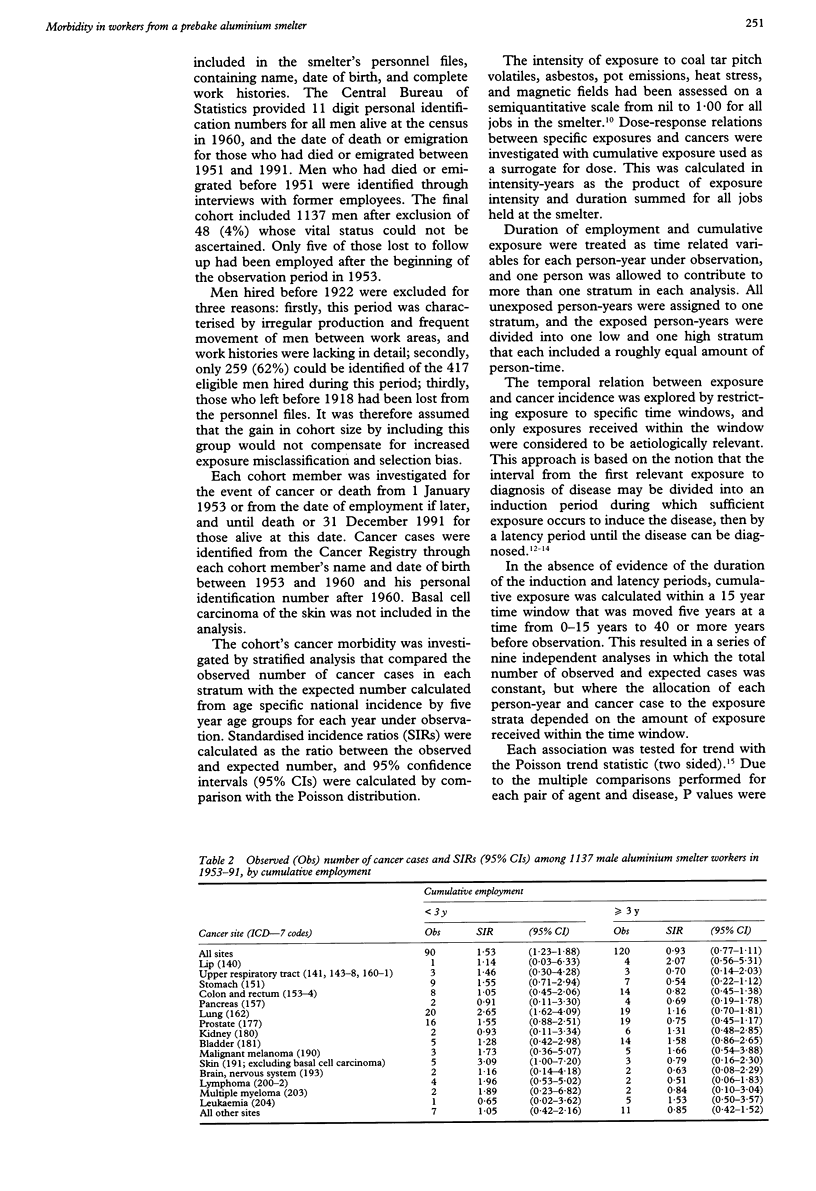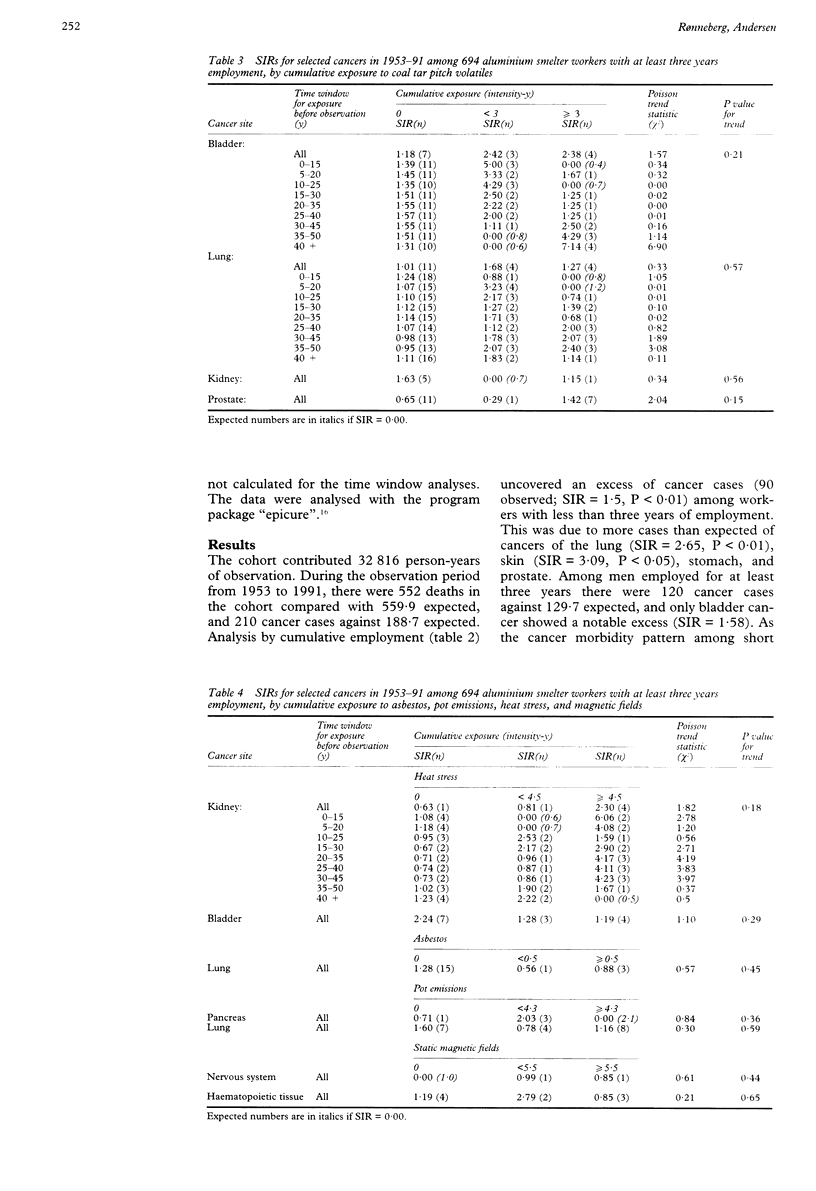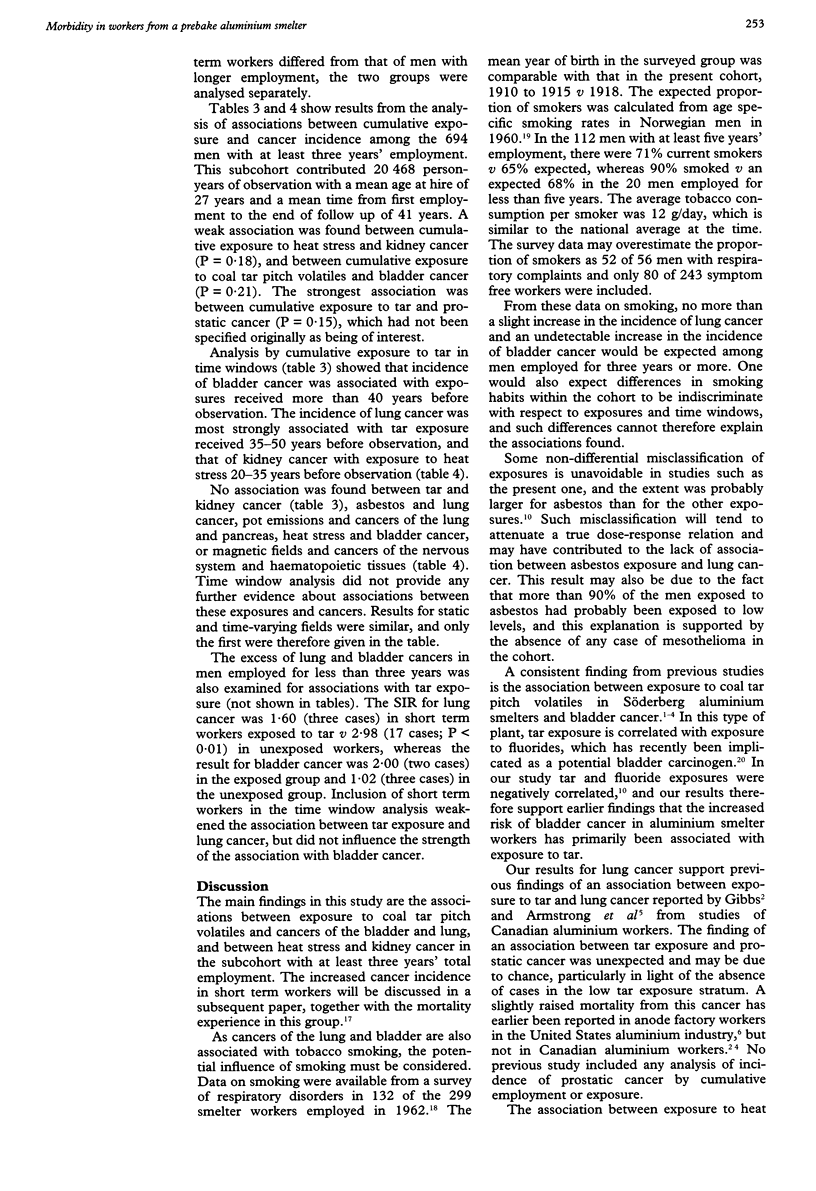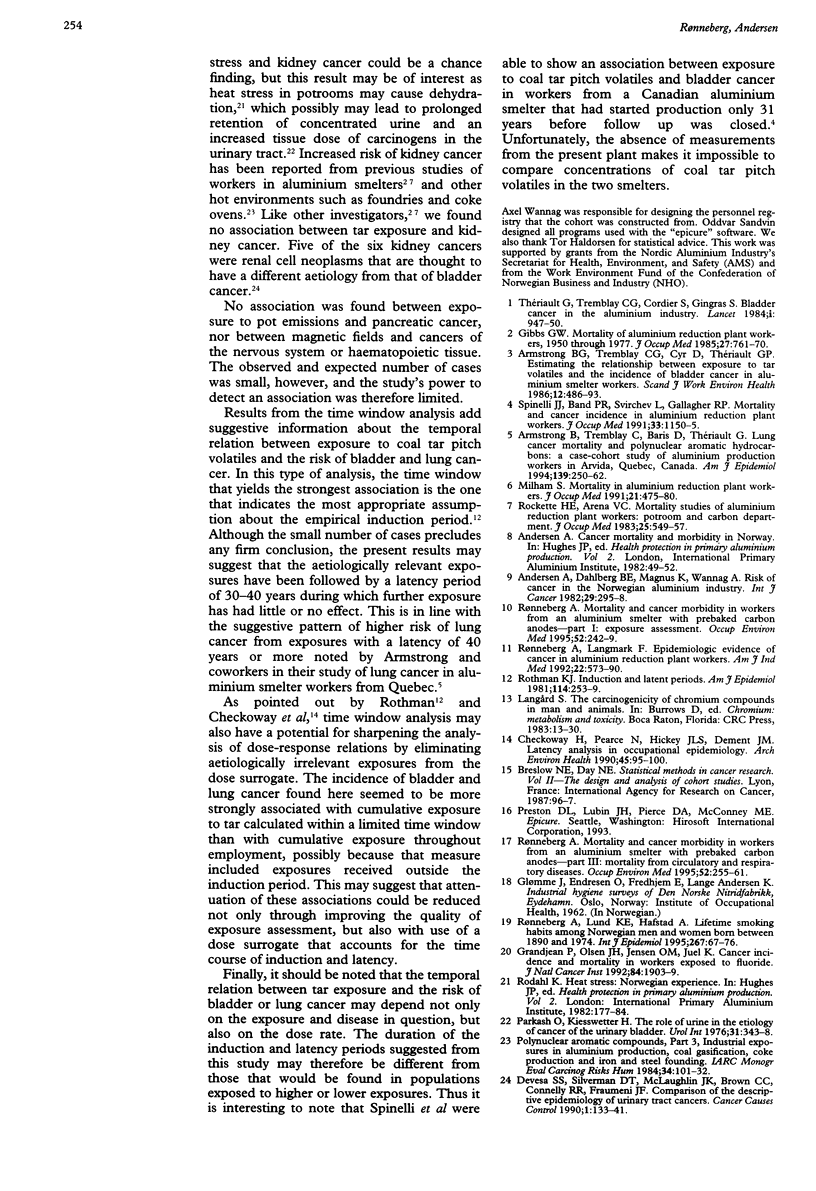Abstract
OBJECTIVE--To investigate associations between cancer incidence and exposure to coal tar pitch volatiles, asbestos, pot emissions (fluorides, sulphur dioxide), heat stress, and magnetic fields in workers from a Norwegian aluminium smelter that operated from 1914 to 1975. METHODS--Cancer incidence between 1953 and 1991 was recorded in a cohort of 1137 men hired between 1922 and 1975. The expected number of cancer cases was calculated from incidence rates in Norwegian men. A job exposure matrix with semiquantitative exposure estimates was used to investigate associations between cumulative exposure estimates was used to investigate associations between cumulative exposure and cancer incidence through exploring temporal relations by considering exposures only within specific time windows. RESULTS--A significant excess of cancer cases, 90 observed v 59.0 expected, was found in workers who had been employed for less than three years. No such excess was found in men with at least three years' employment, with 120 cases observed v 129.7 expected. In this subcohort an association was found between the incidence of bladder cancer and exposure to coal tar pitch volatiles 40 years or more before each person-year under observation, and between incidence of lung cancer and tar exposure 35-50 years before observation. An association was also found between incidence of kidney cancer and exposure to heat stress 20-35 years before observation. CONCLUSIONS--The results support previous findings that exposure to coal tar pitch volatiles in the aluminium industry has been associated with increased risk of bladder and lung cancer. They also add information about temporal relations, suggesting that exposure to tar in this smelter has acted on an early stage in the development of these cancers, followed by a latency period of 30-40 years.
Full text
PDF




Selected References
These references are in PubMed. This may not be the complete list of references from this article.
- Andersen A., Dahlberg B. E., Magnus K., Wannag A. Risk of cancer in the Norwegian aluminium industry. Int J Cancer. 1982 Mar 15;29(3):295–298. doi: 10.1002/ijc.2910290312. [DOI] [PubMed] [Google Scholar]
- Armstrong B. G., Tremblay C. G., Cyr D., Thériault G. P. Estimating the relationship between exposure to tar volatiles and the incidence of bladder cancer in aluminum smelter workers. Scand J Work Environ Health. 1986 Oct;12(5):486–493. doi: 10.5271/sjweh.2109. [DOI] [PubMed] [Google Scholar]
- Armstrong B., Tremblay C., Baris D., Thériault G. Lung cancer mortality and polynuclear aromatic hydrocarbons: a case-cohort study of aluminum production workers in Arvida, Quebec, Canada. Am J Epidemiol. 1994 Feb 1;139(3):250–262. doi: 10.1093/oxfordjournals.aje.a116992. [DOI] [PubMed] [Google Scholar]
- Checkoway H., Pearce N., Hickey J. L., Dement J. M. Latency analysis in occupational epidemiology. Arch Environ Health. 1990 Mar-Apr;45(2):95–100. doi: 10.1080/00039896.1990.9935932. [DOI] [PubMed] [Google Scholar]
- Devesa S. S., Silverman D. T., McLaughlin J. K., Brown C. C., Connelly R. R., Fraumeni J. F., Jr Comparison of the descriptive epidemiology of urinary tract cancers. Cancer Causes Control. 1990 Sep;1(2):133–141. doi: 10.1007/BF00053164. [DOI] [PubMed] [Google Scholar]
- Gibbs G. W. Mortality of aluminum reduction plant workers, 1950 through 1977. J Occup Med. 1985 Oct;27(10):761–770. [PubMed] [Google Scholar]
- Grandjean P., Olsen J. H., Jensen O. M., Juel K. Cancer incidence and mortality in workers exposed to fluoride. J Natl Cancer Inst. 1992 Dec 16;84(24):1903–1909. doi: 10.1093/jnci/84.24.1903. [DOI] [PubMed] [Google Scholar]
- Milham S., Jr Mortality in aluminum reduction plant workers. J Occup Med. 1979 Jul;21(7):475–480. [PubMed] [Google Scholar]
- Parkash O., Kiesswetter H. The role of urine in the etiology of cancer of the urinary bladder. Urol Int. 1976;31(5):343–348. doi: 10.1159/000280070. [DOI] [PubMed] [Google Scholar]
- Rockette H. E., Arena V. C. Mortality studies of aluminum reduction plant workers: potroom and carbon department. J Occup Med. 1983 Jul;25(7):549–557. [PubMed] [Google Scholar]
- Rothman K. J. Induction and latent periods. Am J Epidemiol. 1981 Aug;114(2):253–259. doi: 10.1093/oxfordjournals.aje.a113189. [DOI] [PubMed] [Google Scholar]
- Rönneberg A., Langmark F. Epidemiologic evidence of cancer in aluminum reduction plant workers. Am J Ind Med. 1992;22(4):573–590. doi: 10.1002/ajim.4700220412. [DOI] [PubMed] [Google Scholar]
- Rønneberg A. Mortality and cancer morbidity in workers from an aluminium smelter with prebaked carbon anodes--Part I: Exposure assessment. Occup Environ Med. 1995 Apr;52(4):242–249. doi: 10.1136/oem.52.4.242. [DOI] [PMC free article] [PubMed] [Google Scholar]
- Rønneberg A. Mortality and cancer morbidity in workers from an aluminium smelter with prebaked carbon anodes--Part III: Mortality from circulatory and respiratory diseases. Occup Environ Med. 1995 Apr;52(4):255–261. doi: 10.1136/oem.52.4.255. [DOI] [PMC free article] [PubMed] [Google Scholar]
- Spinelli J. J., Band P. R., Svirchev L. M., Gallagher R. P. Mortality and cancer incidence in aluminum reduction plant workers. J Occup Med. 1991 Nov;33(11):1150–1155. doi: 10.1097/00043764-199111000-00011. [DOI] [PubMed] [Google Scholar]
- Thériault G., Tremblay C., Cordier S., Gingras S. Bladder cancer in the aluminium industry. Lancet. 1984 Apr 28;1(8383):947–950. doi: 10.1016/s0140-6736(84)92399-7. [DOI] [PubMed] [Google Scholar]


